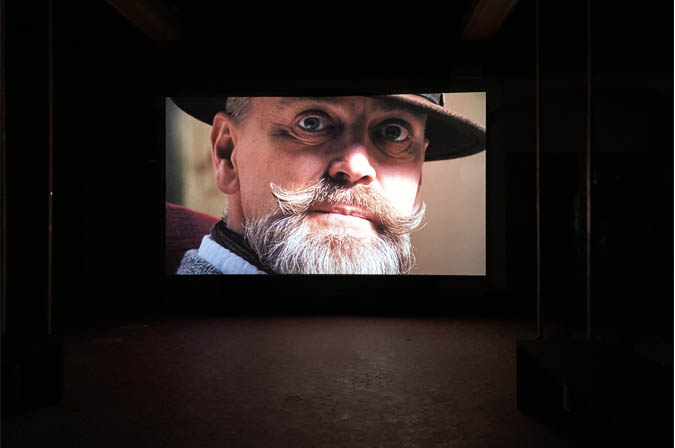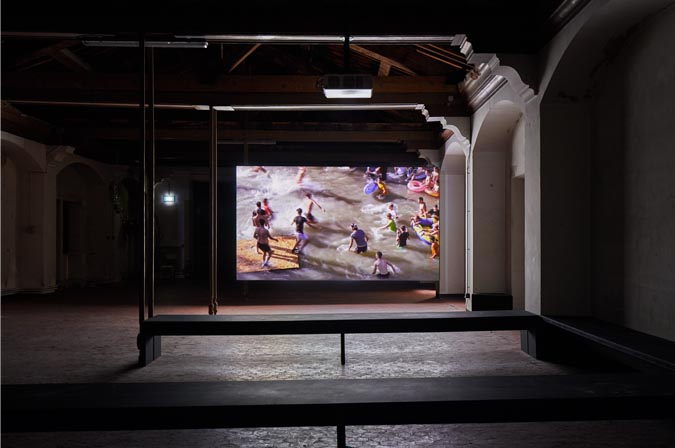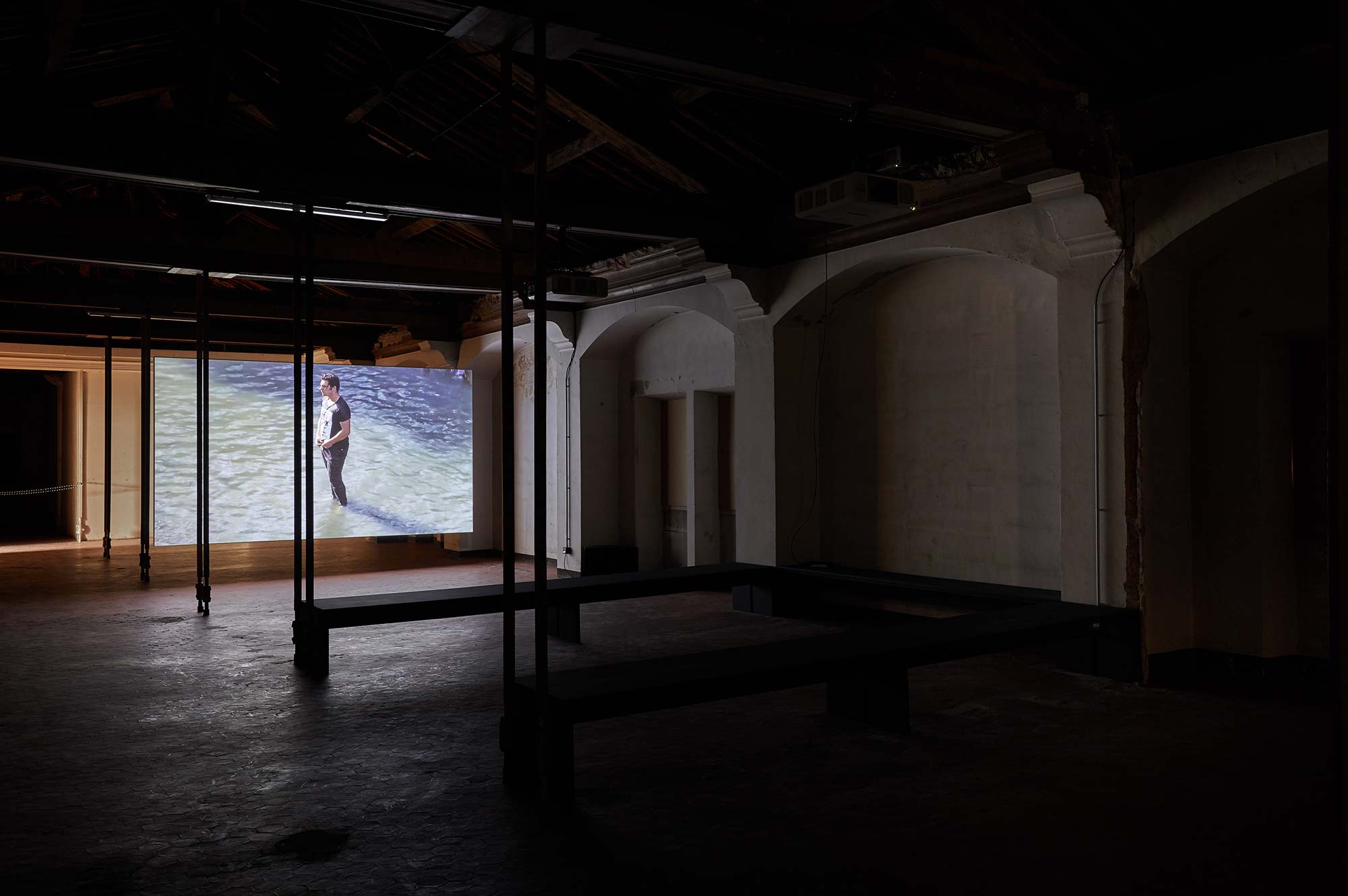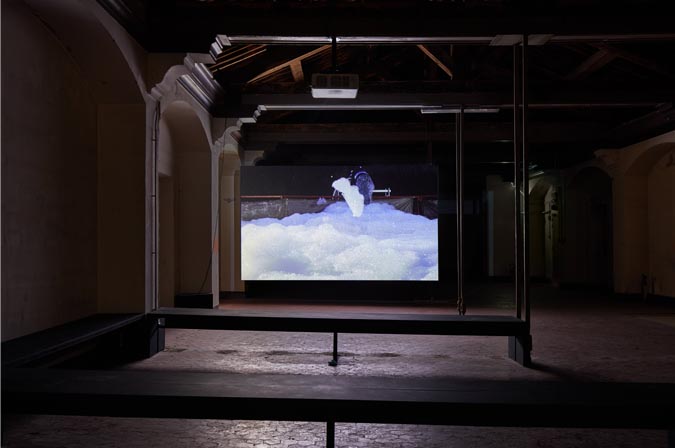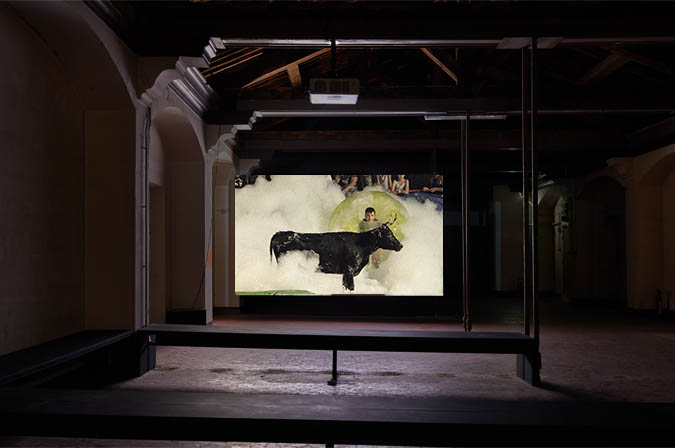Artist and filmmaker Yalda Afsah (b. 1983, DE/IR) explores how space can be cinematically constructed and the documentary character of her works often veers towards forms of theatricality. This formal characteristic of Afsah’s practice is conceptually mirrored in her documentary portraits of human-animal relationships that reveal an ambivalence between care and control, physical strength and broken will, instinct and manipulation. Afsah seeks to question and to dissolve these dichotomies, while carving out a space to reflect on the possibility of an overarching empathy between species.
Tourneur/ Vidourle/ Centaur
Focusing on different encounters between human and animal, Yalda Afsah’s practice continuously explores the possibilities for cinematically constructing filmic space. At the same time, the documentary character of her films fluidly transitions into forms of theatricality. Tourneur (2018) and Vidourle (2019) both document a kind of bullfight practiced in the South of France; meanwhile, Centaur (2020) portrays the classical dressage of horses. Each of these films capture a strange choreography on screen, which could respectively be described as a ritual, a spectacle, a game or a fight – performative acts translated into filmic abstractions.
While the bullfight is a meeting marked by unpredictability, the animals’ movements in dressage are controlled down to the finest detail and seem far removed from the categories of nature, drive or instinct. The insight into how these animals are handled reveals an ambivalence between care and control, physical strength and broken will, instinct and artifice. Afsah allows her protagonists to dissolve these dichotomies – a symbiosis that leaves space for the audience to evaluate the possibility of an overarching empathy between the species, which seems rooted in mutual vulnerability.
Text: Linnéa Bake
Yalda Afsah, Tourneur, 2018
video, colour, sound
14’
Supported by Ammodo and Ifa – Institute for Foreign Cultural Relations
Courtesy of the artist
Yalda Afsah’s short film Tourneur examines an encounter between human and animal; a meeting marked by unpredictability. Documenting a bullfight practiced in a rural area of Southern France, the film builds up a subtle tension through the bull’s initial absence. Initially, this natural force is demonstrated as a potential only.
Everything comes to a standstill in the moment when the bull, the sole protagonist, looks directly into the camera. The animal emerges from the abstract foam landscape typical of this form of bullfighting; he steps into the centre of the screen, turns around once in a circle, and comes to a halt. While the participants and audience are absorbed in a state of ecstasy, seemingly unaware of the camera, the bull directs his gaze straight into the lens.
With one stroke, the bull thus brings the camera into view and transforms the camera’s supposedly ‘objective’ observation into a form of theatricality. Operating at the interface between reality and staging, Afsah explores the possibilities for cinematically constructing filmic space. Camera angles, light and sound are superimposed on the actually occurring scene to theatrical effects. We see the images through a provisionally built framework, like a complex mise-en-scène – it separates us from the shots, much like the circular railing separates the bull fight’s audience from the arena. In the opaque foam, the archaic, ritualised drive to dominate nature becomes a surreal performance.
Text: Linnéa Bake
Yalda Afsah, Vidourle, 2019
HD video, colour, sound
10’
Supported by Ammodo and Ifa – Institute for Foreign Cultural Relations
Courtesy of the artist
Named after its setting, the French river Vidourle, Yalda Afsah’s film documents a strange choreography, capturing a group of young men performing what could be a ritual, a spectacle, a game or a fight.
Pacing back and forth in anticipation, adrenalin-fuelled at times and lost in their thoughts at others, the film’s teenage protagonists seem to be waiting: maybe for something still to come, or possibly something already there. From an almost bird’s eye view, Afsah’s camera looks down at a scene set in a riverbed. The ambiguous perspective detaches the viewer from the scenery below – a subtly unnerving performance, slowly tinged with a sense of threat. Derived from the French word vider (to empty out), the river’s name, Vidourle, is a reminder of the riverbed drying out and filling up again almost every year. This is only but one hint Yalda Afsah gives her audience: that it is a natural force we are awaiting here. As in her previous work, the protagonist of this spectacle is a bull being challenged and chased by the young men in the riverbed – here, however, the animal remains out of the spectators’ sight throughout the entire film.
As a deep-seated anxiety begins to emerge, fear and anticipation are not the only animating forces present in the riverbed – the camera also focuses on the dynamics between the young men proving themselves to others, their collective movements as well as individual moments of concentration and forlornness. In their involuntarily expressed vulnerability, the adolescent protagonists seem to embody the frailty of humanity awaiting an environmental change, much like an unexpectedly forceful current in a river.
Text: Linnéa Bake
Yalda Afsah, Centaur, 2020
HD video, colour, sound
13’
Commissioned by Manifesta 13 Marseille
Supported by Ammodo and Ifa – Institute for Foreign Cultural Relations
Courtesy of the artist
Yalda Afsah’s film Centaur concentrates on an activity shaped by the physical relation between human and animal: the movements in the classical dressage of horses. Controlled down to the tiniest detail, they seem far removed from the categories nature, drive or instinct.
The reduced sound seems to direct our gaze through the riding hall, allowing us to trace the animals’ movements, as Afsah turns their breathing and wheezing, their effort and concentration, into a rhythmic, synthetic soundscape. Decoupled from the events onscreen, the clicking sounds the horse trainer makes evoke a sense of artificiality eerily similar to the aesthetic discipline of dressage itself. In close-up shots, the camera pans across bodies of horses as if they were landscapes. The abstraction of fur, sweat, flexing muscles and intermittent human limbs produces a fusion of horse and rider; a synthesis perceived as ‘symbiotic’ by the horse trainer portrayed. Paired with recurring shots of historical paintings adorning the riding hall, these intimate observations seem to raise the controversial question of whose nature is cultivated by whom. The horse trainer’s leitmotif is the centaur, the human-horse hybrid from Greek mythology. Undoubtedly, the relationship with the animal here becomes a projection screen for various human fantasies.
The insight into how these animals are handled reveals an ambivalence between care and control, physical strength and broken will, instinct and artifice. Afsah allows her protagonists to dissolve these dichotomies – an ambivalent symbiosis that leaves space for the audience to evaluate the peculiar choreography seen on screen.
Text: Linnéa Bake
* Work conceived for the occasion of Manifesta 13 Marseille











